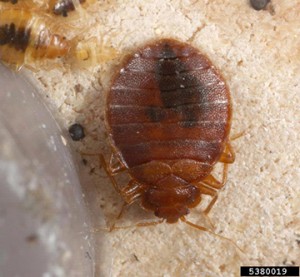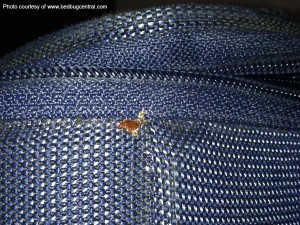Exclusion and sanitation are key factors in structural IPM. Because schools and child care facilities rarely provide the favored overnight buffet found in homes and hotels, bed bugs found in schools and daycare facilities (as well as libraries, restaurants, theaters and public transportation) generally don’t create the same long term infestations. They will, however, be doing their best to find a blood meal, feed, and be on their way in less than fifteen minutes.
No one can prevent a bedbug incident, but the risk of infestation can be reduced if you and your staff learn to be proactive.
Exclusion?
Bed bugs travel via clothing, coats, backpacks, purses, book bags, instrument or document cases, etc. Obviously, checking everyone as they come in the door, and their belongings is unrealistic. Bed bugs don’t hop or fly, so they rely on speedy locomotion and you.
Take note: Exclusion still plays a part in bed bug control, and we’ll discuss this in a future post. And never adopt or accept second-hand furniture without a thorough examination.
Sanitation?
Cleanliness has nothing to do with the presence of bedbugs, but clutter is any pest’s best friend. Clutter provides habitat and makes inspection (scouting) difficult. Large, long term infestations may occur where cleaning and sanitation has lapsed.
Where do they hide?
Insects the size of poppy seeds or apple seeds can find shelter anywhere. They prefer to be close to their food source (why not?) so look in the folds, seams and hidey places in and around upholstered fabric. Use a putty knife, playing card or plastic card along the edges of carpeting, along wall molding and trims, and behind wall art. Visually inspect behind electrical wall plates. (At home, electronics such as bedside clock radios can harbor bed bugs). Any resting place for humans can become bed bug habitat.
If your school has had bed bug incidents, you should be inspecting on a regular basis.
Examine pillows, cushions, seams and all parts of upholstered furniture, including under and inside the frames. Do this in teacher lounges, libraries, auditoriums and any classroom or office with upholstered furniture or a resting area.
Know what you are looking for. Study the photo resources we’ve provided and other online information
Look for active bedbugs, cast skins and tell-tale reddish-brown-to-black spots of excrement.
Reduce clutter. This may be the most difficult step in a classroom. Keeping classroom paraphernalia in totes and keeping them mobile makes inspection and cleaning easier, and reduces bed bug travel opportunities. This is also an excellent way to reduce the chance of ants, cockroaches or mice.
Train your staff on how to reduce the chance of infestation. Also, discuss bedbug prevention openly with staff and students to reduce shaming and ridicule. Do not panic if a bed bug is found. If it’s an isolated case, there is no way to know where that insect came from.
Have a policy in place and know how to capture, keep, and identify a bed bug.
More on Inspection:
Take along a flashlight, putty knife, playing card or plastic card, a screwdriver, wide clear tape, magnifying glass, small zippered bags or tightly-closing plastic containers, facial tissue, tweezers. Have large garbage bags on hand, and remember to fill out an inspection form.
NYSIPM – steps in inspection and collection
BedBug TV: How to inspect a couch
A detailed Bed bug resource from Toronto aimed at public housing



We don’t want to compromise our children’s safety so we better be knowledgeable with how to prevent and /or reduce the risk of having bed bug infestation in school and even in our own homes.